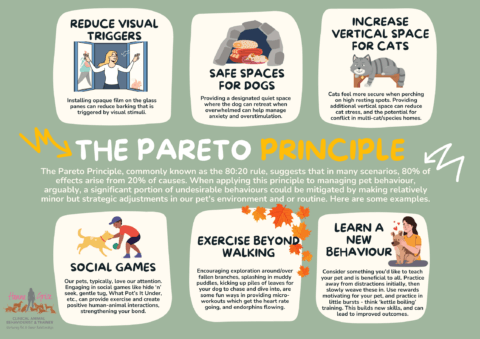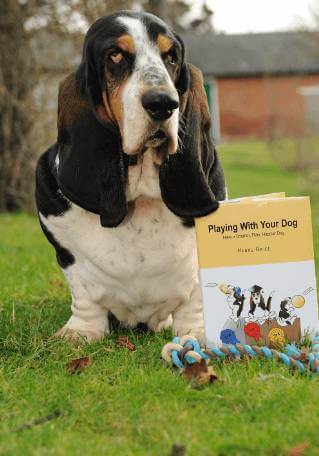The Pareto Principle, commonly known as the 80:20 rule, suggests that in many scenarios, 80% of effects arise from 20% of causes. When applying this principle to managing pet behaviour, arguably, a significant portion of undesirable behaviours could be mitigated by making relatively minor but strategic adjustments in our pet’s environment and or routine.
Consequently, by leveraging this principle, pet carers can create a potent strategy for enhancing their pet’s well-being and curbing unwanted behaviours through focused interventions. Below are examples of some ‘quick wins’ that pet carers can immediately put in place, which could lead to significant improvements.
Managing your pet and their environment

Environmental and management strategies can play a pivotal role in addressing unwanted pet behaviours. For instance, studies on rescue dogs have shown that environmental enrichment, such as the introduction of food puzzle toys, creating comfortable resting areas with duvets and blankets, and changing the appearance of the kennels, not only improves the dogs’ well-being but also makes them more adoptable by positively influencing their behaviour (Luescher and Medlock, 2009). Here are some examples of what you can do at home…
- Reducing visual triggers: if you have a dog that is easily triggered into barking when gazing out of external-facing windows or doors, then installing opaque film on the glass panes can reduce barking triggered by visual stimuli. This strategy can also help cases where cats may be urinating around window frames/patio doors due to being distressed at seeing neighbouring cats around the property.
- Safe spaces for dogs: providing a designated quiet or ‘safe’ space where the dog can retreat when overwhelmed can help manage anxiety and overstimulation (Horwitz, 2008). This space should, ideally, be in the quietest area of the home, somewhere your dog can easily access, and visitors leave the dog be. Such spaces can be particularly helpful when you have unfamiliar people coming into the home (e.g., workmen, window cleaners, etc.), when you are having a party, or when there are significant external sounds which your dog may find worrisome (e.g., a storm, construction work, fireworks, etc.). Ensure your dog has positive experiences within this space – feed them in this area, make the space ‘irresistible’ with cosy bedding, and never place them into this area to punish.
- Sensory enrichment: I have long been a fan of utilising certain sounds to promote relaxation. There is plenty of data to support the use of certain genres of music in lowering pets’ heart and breathing rates, so integrate a favoured album of calming music you and your pet can enjoy, whilst they are resting, licking/chewing on an appropiate item, or enjoying a gentle stroke. Creating an auditory anchor that can promote calmness can be handy for visitor arrivals, when alone (such as overnight, or in their safe space), and to mask ambient sounds which could otherwise worry them.
- Increasing vertical space for cats: our feline friends are semi-aerial species, they feel more secure when perching on high resting spots. Providing additional vertical spaces by installing shelving, cat walks, using window canopies etc., can immediately reduce cat stress and the potential for conflict. Such changes allow cats to escape and hide, as well as observe their surroundings from a safe vantage point (Halls, 2018). Hence, increasing the cat’s territory beyond a cat tree, is hugely beneficial for indoor cats, multi-cat households, or where there is a resident dog[s], if you are thinking for bringing a new pet into the home, or when you have unfamiliar visitors around.
- Vet checks and treatment: whenever you are experiencing a change in your pet’s behaviour or significant increase in unwanted behaviour problems, then your veterinary surgeon should be your first port of call. Your vet can then refer you onto a registered Clinical Animal Behaviourist, who will produce a plan tailored to your pet’s needs. This may include what is called a multi-modal approach; where medication is utilised via your vet (e.g., pain and or behavioural medication if deemed appropiate) alongside management and behavioural training in order to help your pet relax and be able to learn alternative behaviours, guided by your behaviour therapist. Furthermore, your vet can advise on a balanced diet tailored to the dog’s specific needs. Poor diets can affect their energy levels and stress (Murphy, 2016). Consequently, getting the right support via your vet and behaviour therapist can significantly improve the chances for successful outcomes. Check out the Animal Behaviour & Training Council’s Practitioner Directory for a list of certified behaviour therapists near you.
Play, exercise and appropriate enrichment
Pet behavioural problems often occur when the animal’s needs are unmet. This could be related to lack of space/choice, inappropriate diet, undiagnosed health issues etc., as discussed previously. However, behavioural problems can also indicate that other areas of the animal’s life may not be meeting their needs fully or in appropriate ways. Reviewing your pet’s day-to-day life and typical interactions helps in understanding where they may be getting their ‘highs’ and ‘lows’ from. Then, focus can be given to addressing any imbalance by providing structured play, and physical and mental exercise appropriate to that individual animal’s health, abilities, age, breed, and character. If left unaddressed, this could lead to frustration, anxiety and stress, resulting in undesirable behaviour. Examples of what you can do at home include…
- Social interactive games: our pets, typically, love our attention. Engaging in activities like hide and seek (us hiding and them seeking), having a gentle game of tug, or playing games like What Pot’s It Under (featured in my book, Playing With Your Dog) are just some of the ways you can provide some mental and physical exercise whilst providing positive human-animal interactions which can strengthen your bond.
- Exercise beyond walking: introducing different movements, building motor skills, improving problem-solving and honing spatial awareness into your pet’s daily exercise routine can help provide some opportunities for ‘happy hormone’ release. Consider encouraging exploration around/under and over fallen tree branches and splashing in muddy puddles – Parkour style. Kicking up piles of leaves for your dog to chase and dive into can be thrilling for some, while others may enjoy testing their scenting abilities by seeking out hidden items (such as favourite toys, treats, other items) in the park, or initiating games of chase with rod toys, or even yourself and others via dog races (see video example of dog races). These are just some of the fun ways we can enable micro-HIT (high-intensity training) workouts to get the heart rate going, and endorphins flowing.
- Solo play: puzzle toys appropriate to your pet’s skill levels and preference can provide opportunities to encourage solo play, whilst keeping them mentally stimulated. There are a wealth of toys to choose from for dogs, cats and small animals. So, always consider your pet’s abilities, size, health, preferences, and when you are introducing any new toy, help them with it in the early days so they understand how to use it, and you can be sure to build positive associations with it. Otherwise, well-intended puzzle toys can soon become sources of frustration and will be left alone.
- Learn a new behaviour: consider something you would really like to teach your animal and would also be beneficial to them. This might be teaching them to go and settle on a spot or climb up onto a cat tree when asked, keep their head still whilst being inspected or groomed, or perhaps simply to come into the middle and sit between your legs when cued – helpful for recall and in providing a ‘secure base’ for your four-legged friends when needed. As this will involve you teaching your pet the behaviour, a proactive approach is needed along with some of your time. However, such skills can be taught in a relatively short period, if you are strategic (practicing away from distractions to start, then slowly weaving these in at a distance/low intensity, etc.), using rewards that are highly motivating for your pet, and practicing in little bursts. I have always referred to the latter as “waiting for the kettle to boil” training; avoid long durations of practice (see an example of kettle boil training in-practice). By undertaking short and effective sessions, you will build your pet’s repetitions up for the desired behaviour. Ultimately, this will lead to improved results in the longer term, helping improve your pet’s focus and attention on you, and improving the pet-owner relationship.
Key take aways
The application of the Pareto Principle in managing your pet’s behaviour highlights the positive impact that strategic, targeted interventions can have on enhancing their well-being. By concentrating on the critical factors that may prompt your pet’s undesirable behaviour, you can effectively improve your animal’s quality of life – and yours. Hence, through relatively minor changes via thoughtful environmental adjustments, structured and appropiate play, exercise and enrichment, plus positive reinforcement training, this will reduce the practice of unwanted pet problems, meet your animal’s needs, and foster a more harmonious pet-owner relationship. What could be better than that?!
References
- Buffington, C. A. T. (2006). Clinical evaluation of multimodal environmental modification (MEMO) in the management of cats with idiopathic cystitis. Journal of Feline Medicine and Surgery, 8(4), 261-268.
- Horwitz, D.F. (2008) Managing pets with behavior problems: realistic expectations. Veterinary Clinics of North America: Small Animal Practice. 2008 Sep;38(5):1005-21, vi. doi: 10.1016/j.cvsm.2008.04.006. PMID: 18672151.
- Halls, V. (2018). Tools for managing feline problem behaviours: Environmental and behavioural modification. Journal of Feline Medicine and Surgery, 20(11), 1005-1014.
- Luescher, A., & Medlock, R. (2009). The effects of training and environmental alterations on adoption success of shelter dogs. Applied Animal Behaviour Science, 117, 63-68.
- Murphy, M. (2016). Obesity Treatment: Environment and Behavior Modification. The Veterinary clinics of North America. Small animal practice, 46(5), 883-98.
- Strickler, B. G. (2018). Helping Pet Owners Change Pet Behaviours: An Overview of the Science. The Veterinary clinics of North America. Small animal practice, 48(3), 419-431.
Learn more about our classes

Get Hanne's book, clothing and more
Hanne has a number of publications including her book Playing With Your Dog to help owners work out the games that are best suited for their pet to play throughout his life, from puppyhood to old age, available from Amazon. Check out Hanne's range of contemporary casuals The Collection – for pet lovers made from recyclable, organic materials that are sustainably sourced.

